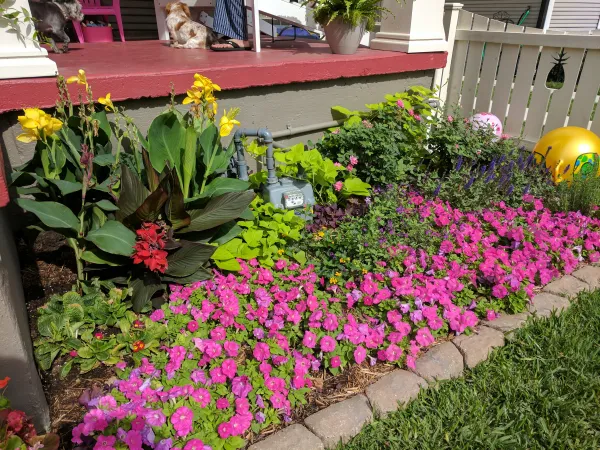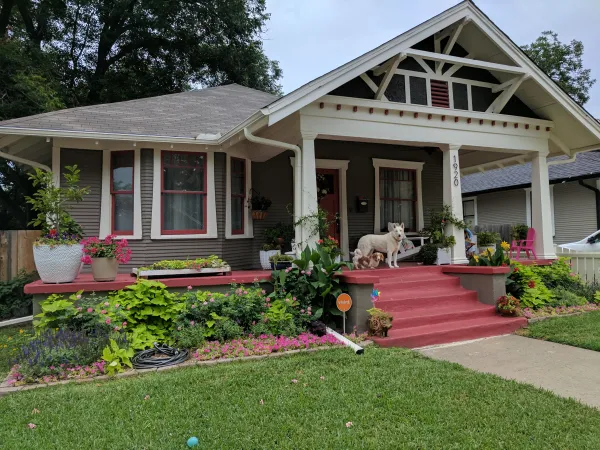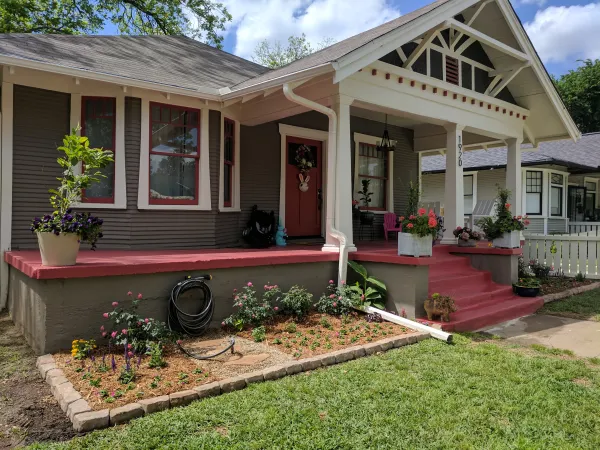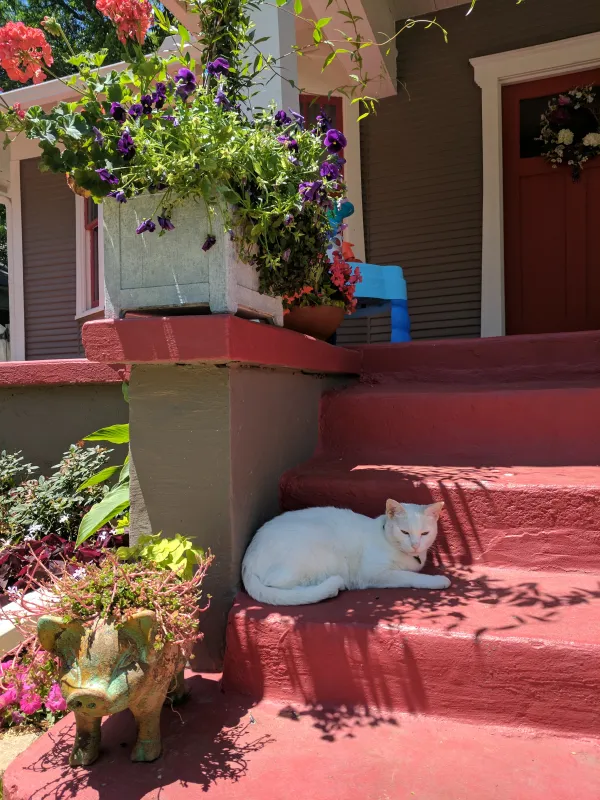1920 Hurley Ave – Yard of the Month (August 2017)
August 8, 2017
News, Yard of the Month

August 2017 Yard of the Month winners are Angela and Ivan DeQuesada of 1920 Hurley Ave. Ivan, a radiologist and Angela, who holds a Masters’ degree in Public Health-Epidemiology, moved to Fairmount from Atlanta in July, 2016. The couple share their home with daughter Charlotte, and a friendly mix of rescue pets: Jerry, the white porch cat, Mochi, a white Shepherd Husky mix, a King Charles spaniel mix, and a high-energy chiweenie puppy given to Charlotte by a neighbor. The DeQuesadas and their brood are only the third family to own this 105-year-old home. Lewis Emmett McLendon bought it in 1924, when the home had been under intermittent construction for a decade. The deed card reveals an uneven progress: there was a nice bathroom, interior plumbing, and electricity in 1924, yet some rooms retained dirt floors and unplastered, shiplap walls (considerably less chic 80 years ago than today). McClendon, born in 1890 in Arkansas, had moved to Dallas in 1923 to support his widowed sister, Nell. After securing a good job with the 11th Division Railway Mail Services, headquartered in Fort Worth, Lewis bought the Fairmount home for big sis and his new bride, Martha, a 31-year-old Georgia native. The Railway Mail Service was a system from 1890 to 1960 for sorting correspondence en route on overland trains. McClendon’s position, coordinating mail delivery to New Mexico, Texas, and Oklahoma, was an important one in north Texas’ busy interstate economy: sorting during transit saved time and space at municipal post offices, rendered travel time productive, and assured that the mail was safely locked up in origin and destination cities.
After the deaths of Lewis and Martha, their only son Lewis Jr. (1926-2006) inherited 1920 Hurley. In 1975, he and wife Dorothy Jean sold the home to empty nesters José and Lidia Bosquez. The Bosquez family left their home in Val Verde county as their children, Lydia, Laura, Josefina and José, Jr., graduated from Sacred Heart Catholic High in Del Rio and enrolled in universities all over North and East Texas. They attended mass at St. Mary of the Assumption, a beautiful Romanesque Revival-style church built in 1924, which remains open for worship at 501 W. Magnolia Ave. José (1931-1996) was an Army veteran, a member of the Knights of Columbus, and a 1963 mayoral candidate in Del Rio, who worked as an accountant in Fort Worth. Lidia (1931-2013) spent four decades teaching school, as did her namesake daughter Lydia Elva, a former nun and high-school calculus teacher in San Antonio. Laura Bosquez, also an educator and a high school principal, purchased 1916 Hurley in 1977 and lived next door to her folks until 1986. 1920 Hurley remained in the Bosquez family until 2015, when Fairmount’s Dustin Collett of DeeCo construction bought and rehabbed it. Like many 100-year-old Fairmount structures, 1920 Hurley needed significant repair to emerge as the beautiful home it is today.
1920 Hurley is a bungalow with Craftsman features. It has bay windows facing the street, an off-center front door, and wide, curved window casing (a decorative feature also visible at 1405 S. Henderson). In 2008, the home had iron porch railings, a primitive wheelchair ramp and a monochromatic color scheme (see photo archive, historicfairmount.com). The landscape was dominated by two large trees in the parkway and tall boxwood shrubs flanking the porch. Those trees, shrubs, and ramp are gone today, and the porch is painted a cheerful red. The cerise palette is amplified elsewhere in the exterior, including the front door, trim on the double-hung windows, attic vent, and dentil motif. The wood siding is painted taupe, the shingles on the front-facing gable are a bluish charcoal, while ornamental roof bracing, tapered columns, trim and Adirondack chairs on the porch are all crisp white.
Clearly, the yard’s showpiece is its unusually charming white picket fence. Angela reports that Charlotte, 3, instantly learned to unlock the front door and charge into the street to greet new neighbors, so installing fencing was a priority.
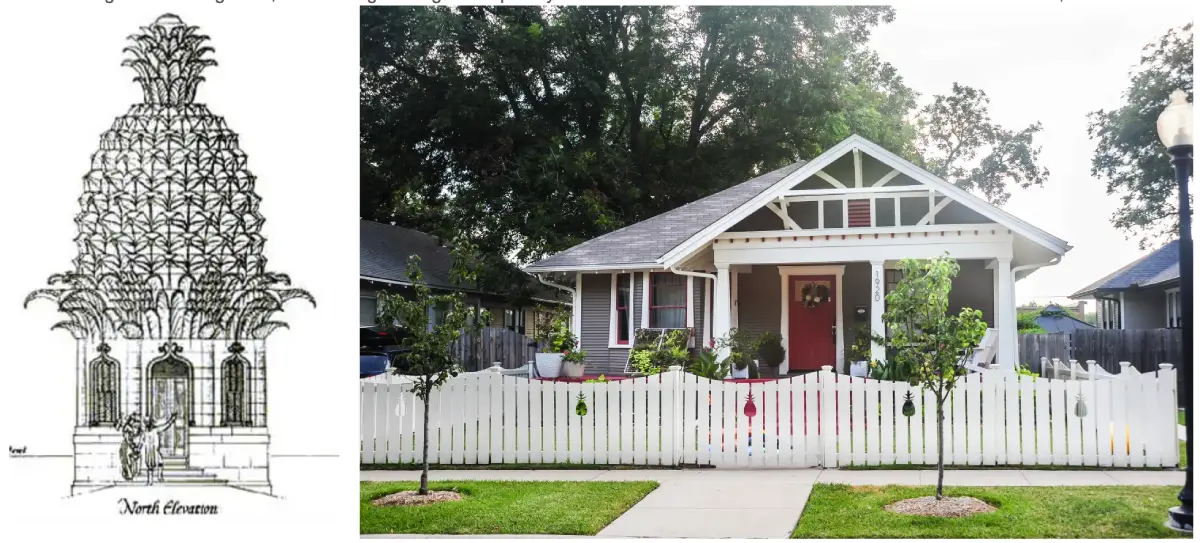
Fairmount’s Akash Patel of Roscoe’s Restoration and Fence, made the enclosure not only an object of utility, but also of beauty and historic import: it is scalloped in a double concave pattern and punctuated every six feet by the stylized outline of pineapples. The pineapple, a member of the bromeliad family, has been a symbol of hospitality since Colonial times, when naval captains would spear the fruit on the front gate posterns to signify a return from a profitable Caribbean voyage: a pineapple out front suggested rum, sugar, coffee, tobacco, tales of naval exploits, and other enticements were within the house. In the unlikely location of Stirling, Scotland, John Murray, the Earl of Dunmore, built his ancestral home’s hothouse in the shape of a 50-foot pineapple in 1761, just before departing to become governor of Virginia (Fran Beauman, The King of Fruits). Jane Austen’s fictional patriarch General Tilney employs a “village” of gardeners to stoke greenhouse ovens around the clock so that his farm might produce 100 pineapples a year in England’s inhospitable climate (Northanger Abbey, 1799).
In the parkway out front, Angela DeQuesada had hoped to bring a little Atlanta with her by planting cherry trees to replace the Live Oaks cut down c. 2008. The fine folks at the Tree Place at I-20 and 287 explained why prunus avium is not ideal for North Texas. Instead, they sold her two young Bradford Pears trees (pyrus calleryana), an ornamental strain with pretty white flowers mimicking the display of sakura (or Japanese cherry tree) blossoms in the springtime. As a bonus, the leaves of the Bradford pear tree also mature into brilliant reds and purples each fall. Even the desiccated, unpicked fruit turns a lovely wine color. Eventually, Bradfords will reach a height of 30 feet, though this spring they gave Angela a scare when they developed “fire blight” (Erwinia Amylovora), a blackening of the tips of branches which had to be carefully extirpated 8-12 inches below the visible damage.
Peeking inside the notable fence, the visitor finds what Victorian Charles Barnard called “pocket handkerchief” garden, with tidy green lawn and symmetrical flower beds. Barnard calculated in 1838 that a square front garden yielded the highest return of both produce and pleasure on the gardener’s time invested. Angela’s plan prioritizes symmetry, clean lines, and repetition. The dominant bloom colors come from a warm palette of pinks, reds and purples. At the back of the beds, flanking the stairs, orange and yellow cannas provide height and drama while enduring hot weather, while pale green sweet potato vines trail onto the grass. Six or eight pink knockout rose bushes in the front beds are flanked by two kinds of salvia, Indigo Spires and Blue Hill (salvia x sylvestris, aka “Blauhügel”). Angela has recently added fresh rows of Cotton Candy Pink and Hot Pink Vincas to replace hot pink “Tidal Wave” petunias, which thrived in the glorious spring weather, but bit the dust as soon as the thermometer climbed beyond 90 degrees.
There are numerous potted plants on the steps and porch, including “creeping turtle” or “Bolivian Jew” (Callisia repens), and the climbing, yellow-flowered Margarita variety of Carolina Jessamine (Gelsemium sempervirens). One planter holds a special place in Angela’s heart: a dear friend from Atlanta mailed an “Ann Magnolia” (magnolia liliflora) as a house-warming present last July. Angela was reluctant to place it in the yard (“it was truly brutally hot,” she recalls), so the pink-flowering magnolia instead graces a giant white container. It also serves to mark the boundary of the porch “so errant children don’t fall off the edge,” until the DeQuesadas are able to install railings.

A vertical hanging garden, about the size of a full bed frame, anchors the porch near the home’s bay windows: this experiment in gravity-defying gardening is planted with succulents, including a ruffled pink echeveria, four-nerve daisy, and more of the absinthe-green potato vine. To the left of the porch, a pink bougainvillea spectabilis is climbing the fence to the back yard, in a bed with lavender and other culinary herbs at its feet. Bougainvillea is a Brazilian native first collected in 1766 by Jeanne Barét, a 26-year-old Frenchwoman who dressed as a young boy to apprentice herself to botanist Philibert Commerson, on Louis Antoine de Bougainville’s ship the Etoile. When the Etoile landed in Tahiti in 1768, locals immediately recognized Barét as a mahu (a third-gender person), and a Tahitian ambassador informed her surprised French captain that she was a non-binary adult, not a young boy. Though his journals reveal his anger at Barét, Captain Bougainville needed her very badly, as Commerson was dying of diabetes-related ailments and could not leave his cabin to conduct botanic research. After her retirement, Barét became the first woman to receive a pension from the French marine ministry for her contributions to botany and maritime exploration.
For uniting so many historically worthy botanical references in the yard of their Hurley Street home, the DeQuesadas have our sincere thanks, and a gift certificate to Stir Crazy Baked Goods for $30.
The Yard of the Month board is Susan Harper and Bonnie Blackwell.
Pictures below were shared from the homeowners.
- Share

